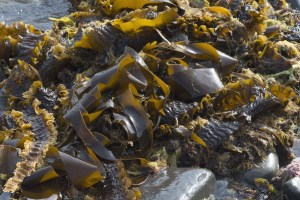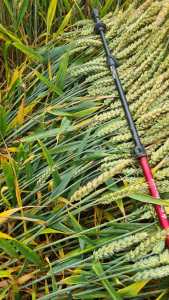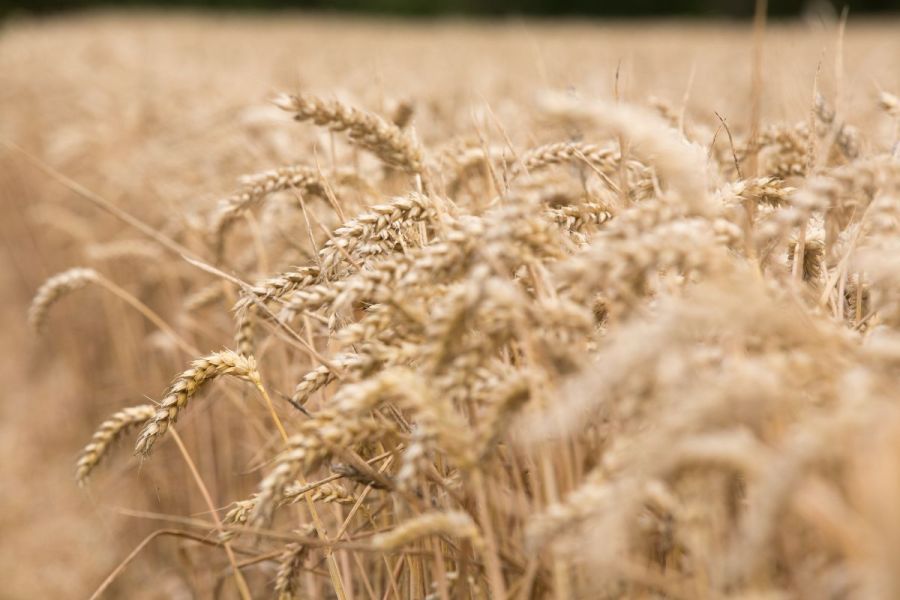Navigating disease control with an ever-declining chemical armoury is a challenge for many, so could leaning on historic natural options be beneficial in bolstering crop protection? CPM looks at the innovation behind two naturally-derived products.
“Lodus gives you that piece of mind that you’re enhancing the plant’s own ability to fight septoria.”
By Charlotte Cunningham
The loss of chlorothalonil (CTL) in 2020 marked a step-change in how septoria is controlled in wheat crops, leaving many growers with a gaping hole in their crop protection programmes.
But with growers grappling for new solutions to tackle the yield-robbing disease, the loss of CTL has provided an opportunity for older, spruced-up alternatives to step back into the spotlight – as well as the launch of new products hoping to provide a useful alternative in a post-CTL world.

As well as filling a gap post-CTL, the driver behind the development of Thiopron was to improve formulation and disease control over the WG alternatives, explains Stuart Jackson.
Among those alternatives is sulphur – an essential element in crop production, with long-standing proven benefits as both a fertiliser and a fungicide.
However, though sulphur has been around for some time, challenges with particle size and formulation of traditional older products has somewhat restricted just how useful and usable it is to growers, explains Stuart Jackson, head of technical services at UPL. “The beginning for sulphur is historical – it goes back a very long way and has been recognised as having fungicidal properties potentially as far back as Egyptian and Roman times.”
Today, there are two main grades of sulphur – fertiliser and fungicide. “Fertiliser grades of sulphur are usually presented as a sulphate and are generally very variable in terms of particle size, with a lot of very big particles in there,” explains Stuart. “While this is great for getting nutrition into the plant, the challenge with this is that it often results in poor leaf coverage, which allows fungal infections to pass through, as well as poor sublimation which can any limit fungicide activity from the sulphur.”
To overcome this, fungicide formulationsof sulphur started to appear – known as water-dispersible granules (WDG or WG) – which had a smaller average particle size of 3 microns, he adds. “These are products like Microthiol WDG – which is a powdered formulation of sulphur – and consists of elemental sulphur, which is more consistent and smaller in terms of particle size than sulphur used in fertilisers. The benefit of this is better coverage and sublimation. While it’s targeted at disease control, the big particles also help get some nutrition into the plant.”
While the particle size and consistency are improved in this formulation, the powdered state still poses a challenge for many users, says Stuart. “Particularly for spray operators, powdered formulations aren’t the easiest and, in the past, have been renowned for tank-mix and compatibility problems.”
To combat this, a new liquid formulation – Thiopron – was developed by UPL as one of two new bio-fungicide options, the other being the elicitor Iodus (laminarin), which were introduced in 2020 to, initially, help fill the gap following the loss of CTL.

Laminarin is derived from natural plant extracts and works by provoking a response from the plant to trigger its own natural defences so that it is able to defend itself from any future attacks.
“UPL has been involved with sulphur for over 100 years, and liquid sulphur itself has been around since 1978, with application largely focused on fruit and vegetable crops,” explains Stuart.
“But, as well as filling a gap post-CTL, the driver behind the development of Thiopron was to improve formulation and disease control over the WG alternatives, designed specifically for the cereal market.
“The benefit of going to a liquid is that you get an easier-to-handle formulation – growers and spray operators have told us they prefer a liquid – and it also means you can start to add different adjuvants and wetting systems in there to help spread and move it on the leaf surface, and importantly, stick the product to the leaf surface and give it that rainfastness as well.”
But what about improved disease control? Registered for use at T1 and T2, Thiopron is a finely milled liquid elemental sulphur consisting of ultra-fine 1.2-micron particles. “The advantage of Thiopron over previous forms of sulphur is optimised formulation – with the addition of an adjuvant. Trials have shown the coverage is actually twice as good compared with a WG type,” explains Stuart. “The addition of the adjuvant Xanthane in the formulation also improves that coverage further and aids adhesion to the leaf and rainfastness.”
So why is this size and consistency so important? “The liquid formulation of sulphur reacts on the leaf surface to produce hydrogen sulphide gas but even coverage is crucial for optimum gas production and persistency,” explains Stuart.
“Sulphur as a fungicide is slightly different to fertiliser formulations as it requires a very specific – and consistent – particle size to enable surface coverage and gas production to occur.”
When the gas is formed, it’s toxic to pathogens like septoria and powdery mildew, he adds. “The gas is also anti-sporulant, which means that it can both prevent an infection from occurring and prevent spore release, stopping re-infection from disease that’s already present. So essentially, you see a longer length of disease control in the plant.”
Though there are many benefits of this improved formulation, Stuart says it’s important to keep in mind how the particle size has changed during the development of sulphur products and what this means from a plant perspective. “As we’ve moved from bigger to smaller particles, while we’ve improved the disease control capabilities of sulphur, we’ve lost what it can do in terms of plant nutrition.
“So while Thiopron is great in terms of its fungicidal properties, it’s not so good for getting sulphur into the plants – if that’s your goal then you’re better off going with something that has a bigger particle size, such as Microthiol WG.”
As such, the product found its final market position as a fungicide – specifically, a bio-fungicide – with a range of diseases and crops on its label. It’s recommended at a rate of 2-3 l/ha and has extensive compatibility with typical T1 and T2 programmes, plus a wide range of tank-mixes. “One of the other main benefits is that it’s a residue-free product and can also be used in both conventional and organic systems,” notes Stuart.
Throughout its development, Thiopron has been trialled in a number of different situations over multiple years before its launch. “With regards to septoria, Thiopron has demonstrated the ability to provide at least equivalent disease reductions to folpet, with the added benefit of activity against powdery mildew – and this has been proven over many years, sites and situations – making it a robust alternative multi-site to consider this season.”
Studies have also looked at yield benefits in winter wheat and found that an application of 1 l/ha of Ascra Xpro (bixafen+ fluopyram+ prothioconazole) at T1, followed by 1 l/ha Revystar XE (mefentrifluconazole+ fluxapyroxad) plus 2 l/ha of Thiopron produced the best yield across three trials, at an average of 10.6t/ha. This is compared with 10.4t/ha where the Thiopron was omitted and replaced with folpet at a rate of 1 l/ha.
The second innovation – Iodus – is registered for the control of septoria and reduction of powdery mildew in winter wheat and contains the active ingredient laminarin – a natural plant extract from a specific seaweed species, Laminaria digitata, which has a similar structure to the degraded products from disease damaged cells. “The decision was taken to register it as a fungicide under biopesticide regulations from the CRD. While we didn’t need to do that, we felt it was the right thing to do because ultimately these types of products are going to be needed to be registered at some point – legislation will eventually catch up and come in,” explains Stuart.
So how does it work? First developed in 2003, laminarin works by provoking a response from the plant to trigger its own natural defences so that it’s ready to defend itself from any future attacks, with approval in cereals granted for UK growers in 2020. “Essentially, it tricks a plant into thinking it’s under attack and then the plant responds with its inherent resistance mechanisms,” he says. “It takes about 48 hours from application for the plants defences to be fully activated. Iodus essentially allows growers to take a preventative approach so that it is primed and ready to deal with any future attacks.”
This line of defence is triggered via three main pathways, explains Stuart. “Firstly, the cell walls are strengthened to reduce infection – the stronger the cell wall, the more difficult it is for the pathogen to penetrate and establish a foothold in the plant and modify what it is doing. It also produces phytoalexins, which are essentially the plant’s own chemical factory to help fight the pathogen attacking it. Finally, it produces pathogenesis response proteins, which are specific proteins for specific diseases, to combat the pathogen and signal to other cells to prepare a defence.”
Part of the development stage involved rigorous trials and testing. During field trials conducted in 2019 and 2020, Iodus provided a mean control of septoria of 57.25% – based on an application rate of 0.75 l/ha. This is compared with 58.25% control from folpet used at 1.5 l/ha and 53.56% from 1 l/ha chlorothalonil.
Trials across the same years also revealed a yield advantage. “When applied at T0, Iodus delivered on average a 0.3t/ha uplift yield in a wheat crop. This is equivalent to the typical yield benefit given by conventional multi-site fungicides when applied at the T0 timing,” explains Stuart.
In terms of application, Iodus is recommended as a single dose at T0 – at a rate of 0.75 l/ha – in order to prepare and prime the crop for the season ahead. It’s also compatible with a wide range of products as part of a tank-mix. “Overall, we believe that Iodus has the potential to play a really big role in terms of supporting the control of septoria – particularly in regions like the West which are traditionally hit quite hard,” says Stuart. “In a world without CTL, disease control is all about looking at what else we have available and how we can incorporate all the tools on hand to bring about the best level of control.”
View from the field

David Lines believes that Iodus is one of the best protectant alternatives against septoria in a post-CTL era.
Covering 4000ha of combinable crops in Herefordshire, Shropshire and the Welsh borders, AICC member and independent agronomist David Lines is well-versed in disease control. And in the “wet West” it’s septoria that remains the biggest challenge to growers and wheat crops in particular.
“We have blackgrass, but not like in the East. For us, it’s disease control that’s our major threat and predominantly septoria. We do have yellow rust here too, but as we’re using such high doses of chemistry for the septoria, it isn’t really a major priority.”
Tackling septoria starts with getting variety choice and drilling date right, says David. “I don’t think I’ve got anyone here growing wheat with a resistance score for septoria of less than 6.5 – the message has got through now that it’s equally important to look at disease scores as well as yield.
“Drilling date is also part of the line of defence and, even with blackgrass, we don’t tend to drill late – we just can’t risk it with the weather. In the odd year, we might manage to go a bit later – but that’s been just pure luck.”
But even with inherent resistance within varieties, crops still require support with crop protection products and, historically, CTL had been the go-to for David. “Life was a lot easier with CTL – we had good protectant chemistry that was cheap,” he notes. “Traditionally, I would have gone in with CTL at T0, T1 and T2, but we haven’t got that anymore and unfortunately it’s something we have to accept.”
Though the loss of CTL left a hole in the strategy for many growers, tackling septoria still requires a robust T0-T2 approach, says David, and to fill the gap at T0 he recommends Iodus.

In AICC trials, Iodus has consistently given a 0.3t/ha yield response over untreated wheat.
“I’ve had laminarin – the active in Iodus – in trials since 2017, after being approached to assess it in independent work for the West region. During the first year, we had it going on at all different timings, but what we’ve found is that it works best when applied at T0.”
These trials involved assessing Iodus against untreated wheat, as well as in comparison with alternatives such as folpet. So how does it stack up?
“What’s important to remember is that Iodus – or any product in fact – is not CTL. That said, across the several years of AICC trials, Iodus has consistently given us a 0.3t/ha yield response over untreated wheat,” explains David.
“When compared with folpet, Iodus has also delivered at the T0 timing – giving a similar yield response – but that has also continued throughout the season, and we found we were able to reduce rates of chemistry at later timings due to the control achieved at T0.
“Overall, with Iodus, the crops just seem to look a little bit healthier. It’s hard to quantify that, but essentially, wheat just looks that bit cleaner where it has been used.
David adds that in terms of economics, Iodus is also more competitively priced than other alternatives. “Last year, I used it in about 90% of my crops – it’s a good substitute in a post-CTL era.”
And what do growers think? “With the farmer and agronomist relationship, it’s all about trust, and I think after doing this for many years that they trust my judgment,” he laughs. “Ultimately, we can bemoan the fact we haven’t got CTL anymore, but that doesn’t change it. Iodus gives you that piece of mind that you’re enhancing the plant’s own ability to fight septoria – which is really important for us in this region. To my mind, this is the best of the protectant products out there.”
Innovation Insight
CPM would like to thank UPL for kindly sponsoring this article, and for providing privileged access to staff and material used to help put the article together.
This article was taken from the latest issue of CPM. For more articles like this, subscribe here.
Sign up for Crop Production Magazine’s FREE e-newsletter here.




